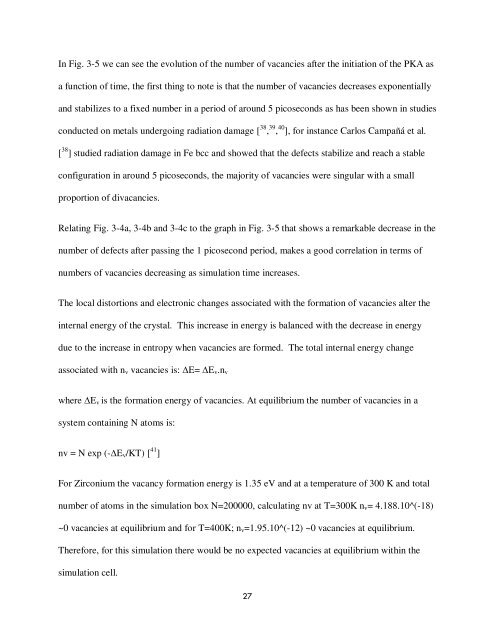DEFECTS IN METALS AND SIMULATION OF MECHANICAL ...
DEFECTS IN METALS AND SIMULATION OF MECHANICAL ...
DEFECTS IN METALS AND SIMULATION OF MECHANICAL ...
You also want an ePaper? Increase the reach of your titles
YUMPU automatically turns print PDFs into web optimized ePapers that Google loves.
In Fig. 3-5 we can see the evolution of the number of vacancies after the initiation of the PKA as<br />
a function of time, the first thing to note is that the number of vacancies decreases exponentially<br />
and stabilizes to a fixed number in a period of around 5 picoseconds as has been shown in studies<br />
conducted on metals undergoing radiation damage [ 38 , 39 , 40 ], for instance Carlos Campañá et al.<br />
[ 38 ] studied radiation damage in Fe bcc and showed that the defects stabilize and reach a stable<br />
configuration in around 5 picoseconds, the majority of vacancies were singular with a small<br />
proportion of divacancies.<br />
Relating Fig. 3-4a, 3-4b and 3-4c to the graph in Fig. 3-5 that shows a remarkable decrease in the<br />
number of defects after passing the 1 picosecond period, makes a good correlation in terms of<br />
numbers of vacancies decreasing as simulation time increases.<br />
The local distortions and electronic changes associated with the formation of vacancies alter the<br />
internal energy of the crystal. This increase in energy is balanced with the decrease in energy<br />
due to the increase in entropy when vacancies are formed. The total internal energy change<br />
associated with n v vacancies is: ∆E= ∆E v .n v<br />
where ∆E v is the formation energy of vacancies. At equilibrium the number of vacancies in a<br />
system containing N atoms is:<br />
nv = N exp (-∆E v /KT) [ 41 ]<br />
For Zirconium the vacancy formation energy is 1.35 eV and at a temperature of 300 K and total<br />
number of atoms in the simulation box N=200000, calculating nv at T=300K n v = 4.188.10^(-18)<br />
~0 vacancies at equilibrium and for T=400K; n v =1.95.10^(-12) ~0 vacancies at equilibrium.<br />
Therefore, for this simulation there would be no expected vacancies at equilibrium within the<br />
simulation cell.<br />
27

















